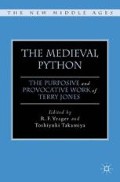Abstract
One of the targets of Terry Jones’s comic-satirical “history” programs for television was the medieval church. There was much fun to be got out of its corruption and hypocrisy and ridiculousness, and also that delightful whiff of scandalous outrage that these things should have gone on and been allowed and, it was hinted, should have been kept from us by stuffy academic historians. It was, with a nod to the popular press and a baseline assumption of the public’s ignorance, a kind of exposé. It was never thus, of course, neither in real-life history nor in “history,” but in satirizing the medieval church, especially the orders of monks and friars, Terry joined a long line of satirists in the estates-satire tradition, John Gower and Geoffrey Chaucer among them. In this essay I want to look again at this tradition, with an eye to another possible view of the story. Maybe medieval monks and friars were not always, or even ordinarily, fat, greedy, lecherous, and hypocritical, or at least did not yield themselves up so readily to ridicule as such. The problem is that, whatever I manage to say, it will not be nearly as much fun as the Terry Jones vision of history, for which, still, we thank him.
Access this chapter
Tax calculation will be finalised at checkout
Purchases are for personal use only
Preview
Unable to display preview. Download preview PDF.
Notes
Dom David Knowles, The Monastic Order in England 940–1216 (1940; 2nd ed., Cambridge: Cambridge University Press, 1963), 220.
An excellent general survey is given by Penn R. Szittya, The Antifraternal Tradition in Medieval Literature (Princeton, NJ: Princeton University Press, 1986).
See Wendy Scase, Piers Plowman and the New Anticlericalism (Cambridge: Cambridge University Press, 1989), 32–39, 113–17. William St. Amour anticipates Langland in associating the friars with imminent apocalypse.
See Jack A.W. Bennett and Geoffrey V. Smithers, ed., Early Middle English Verse and Prose (Oxford: Clarendon Press, 1966), 142.
Jill Mann, Chaucer and Medieval Estates Satire (Cambridge: Cambridge University Press, 1973), 17–37.
See Derek Pearsall, John Lydgate (1311–1449): A Bio-bibliography, English Literary Studies, Monograph Series No. 71 (Victoria, BC: University of Victoria, 1997), 35, 37.
Walter W. Skeat, ed., Pierce the Ploughmans Crede, EETS, o.s. 30 (1867).
See V.J. Scattergood, Politics and Poetry in the Fifteenth Century (London: Blandford Press, 1971), 239–45, with quotation from Peter L. Hey worth, ed., Jack Upland, Friar Daw’s Reply and Upland’s Rejoinder (London: Oxford University Press, 1968).
For these two pieces, see R. B. Dobson and J. Taylor, Rymes of Robyn Hood: An Introduction to the English Outlaw (Book Club Associates, 1976), 113–22, 208–214; cf. also 158–64. For Friar Tuck’s name, see 41.
Norman Davis, ed., The Paston Letters, 2 vols (Oxford: Clarendon Press, 1976), 2: 221
Peter Whiteford, ed., The Myracles of Oure Lady (from Wynkyn de Worde’s print), Middle English Texts, 23 (Heidelberg: Carl Winter, 1990), 134–38.
Carleton Brown, ed., English Lyrics of the Thirteenth Century (Oxford: Clarendon Press, 1932), 126.
Editor information
Copyright information
© 2012 R. F. Yeager and Toshiyuki Takamiya
About this chapter
Cite this chapter
Pearsall, D. (2012). Medieval Monks and Friars: Differing Literary Perceptions. In: Yeager, R.F., Takamiya, T. (eds) The Medieval Python. The New Middle Ages. Palgrave Macmillan, New York. https://doi.org/10.1057/9781137075055_7
Download citation
DOI: https://doi.org/10.1057/9781137075055_7
Published:
Publisher Name: Palgrave Macmillan, New York
Print ISBN: 978-1-349-29459-6
Online ISBN: 978-1-137-07505-5
eBook Packages: Palgrave Literature CollectionLiterature, Cultural and Media Studies (R0)

